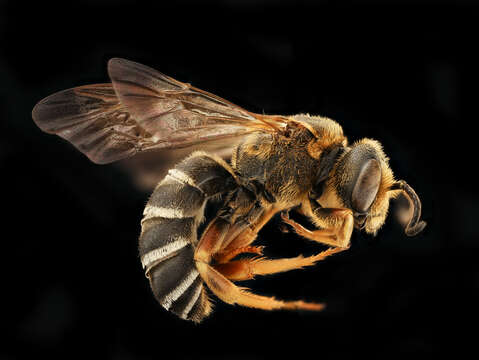Halictus parallelus, m, right, Prince George's Co, MD_2019-03-21-23.21.33 ZS PMax UDR

Descrição:
Kinda Sorta Similar. Last post was of a Dieunomia, this one is of a Halictus. Halictus parallelus, the largest of the eastern Halictus. They kinda sorta look similar, same family, but different genera. But once you drill in differences emerge in shape of the wing veins, colors on the face, the fanciful architecture of the male legs in Dieunomia (So weird I thought I had a wasp when I caught my first one...). More like the difference between mule deer and elk. Really, I don't know where I am going with this, but this can happen to you when you use spontaneous writingship, lack an editor, believe in the free punctuation movement, and were traumatized as a child through imposition of the fake science of sentence diagramming. Finally, I like this bee, and enjoy seeing them in a field collection since they don't really hang out so much in junk habitat. Photo by Brooke Goggins. ~~~~~~~~~~{{{{{{0}}}}}}~~~~~~~~~~ All photographs are public domain, feel free to download and use as you wish. Photography Information: Canon Mark II 5D, Zerene Stacker, Stackshot Sled, 65mm Canon MP-E 1-5X macro lens, Twin Macro Flash in Styrofoam Cooler, F5.0, ISO 100, Shutter Speed 200 We Are Made One with What We Touch and See We are resolved into the supreme air, We are made one with what we touch and see, With our heart's blood each crimson sun is fair, With our young lives each spring impassioned tree Flames into green, the wildest beasts that range The moor our kinsmen are, all life is one, and all is change. - Oscar Wilde You can also follow us on Instagram - account = USGSBIML Want some Useful Links to the Techniques We Use? Well now here you go Citizen: Best over all technical resource for photo stacking: www.extreme-macro.co.uk/ Free Field Guide to Bee Genera of Maryland: bio2.elmira.edu/fieldbio/beesofmarylandbookversion1.pdf Basic USGSBIML set up: www.youtube.com/watch?v=S-_yvIsucOY USGSBIML Photoshopping Technique: Note that we now have added using the burn tool at 50% opacity set to shadows to clean up the halos that bleed into the black background from "hot" color sections of the picture. www.youtube.com/watch?v=Bdmx_8zqvN4 Bees of Maryland Organized by Taxa with information on each Genus www.flickr.com/photos/usgsbiml/collections PDF of Basic USGSBIML Photography Set Up: ftp://ftpext.usgs.gov/pub/er/md/laurel/Droege/How%20to%20Take%20MacroPhotographs%20of%20Insects%20BIML%20Lab2.pdf Google Hangout Demonstration of Techniques: plus.google.com/events/c5569losvskrv2nu606ltof8odo or www.youtube.com/watch?v=4c15neFttoU Excellent Technical Form on Stacking: www.photomacrography.net/ Contact information: Sam Droege sdroege@usgs.gov 301 497 5840
Incluído nas seguintes páginas:
- Life
- Cellular
- Eukaryota (Eucariontes)
- Opisthokonta
- Metazoa (Reino Animal)
- Bilateria
- Protostomia (Protostômios)
- Ecdysozoa
- Arthropoda (artrópode)
- Pancrustacea
- Hexapoda
- Insecta (insetos)
- Pterygota
- Neoptera
- Endopterygota
- Hymenoptera (formigas, abelhas e vespas)
- Apocrita
- Aculeata
- Apoidea
- Anthophila
- Halictidae
- Halictinae
- Halictini
- Halictus
- Halictus parallelus
Esta imagem não aparece em nenhuma coleção.
Informação de origem
- licença
- cc-publicdomain
- direitos autorais
- USGS Bee Inventory and Monitoring Lab
- fotógrafo
- USGS Bee Inventory and Monitoring Lab
- original
- arquivo de mídia original
- visite a fonte
- site do parceiro
- USGS Bee Inventory and Monitoring Lab
- ID


